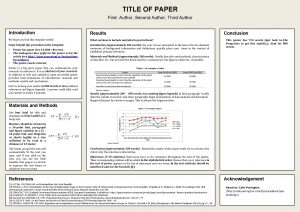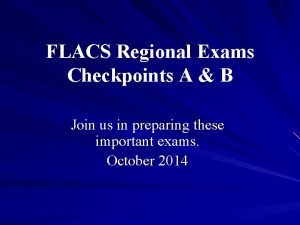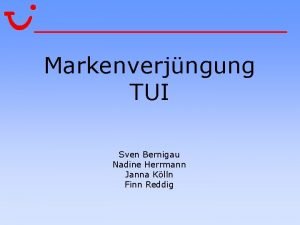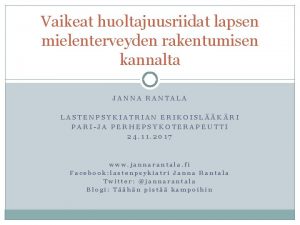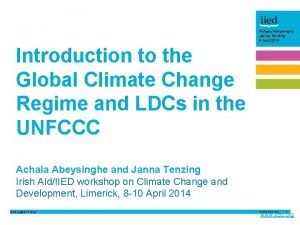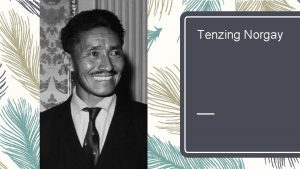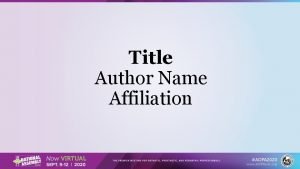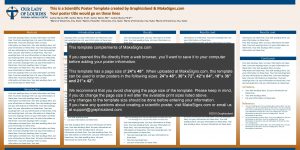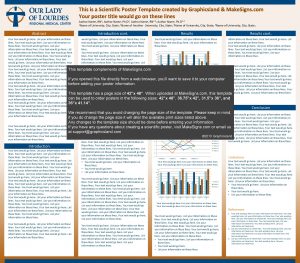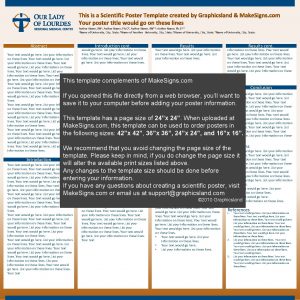Janna Tenzing June 2014 Janna Author Tenzing name








- Slides: 8

Janna Tenzing June 2014 Janna Author Tenzing name Date 2014 June Gender equality and climate change An introduction GENDER EQUALITY AND CLIMATE CHANGE 1

Key concepts Janna Tenzing June 2014 • “Gender”: social roles and relations between women and men; includes different responsibilities of women and men in a given culture or location socially constructed roles can change over time and vary according to geographical location and social context. • • Gender equality (GE): “equal enjoyment by women and men of socially-valued goods, opportunities, resources and rewards” Women’s empowerment is a critical aspect of GE FAO (2007) People-centred climate change adaptation: integrating gender issues GENDER EQUALITY AND CLIMATE CHANGE 2

Gender equality and climate change Janna Tenzing June 2014 Women and men experience climate change in distinct ways: • Different risks and opportunities due to genderbased division of labour and sociocultural barriers • Different options and safety nets for coping with climate change due to gender-based differences in access to physical, social and financial resources • Differences in knowledge and skills to prepare for or cope with climate change • Differences in levels of representation, participation and leadership FAO (2007) People-centred climate change adaptation: integrating gender issues GENDER EQUALITY AND CLIMATE CHANGE 3

A gender approach • • Janna Tenzing June 2014 Recognises differences in vulnerabilities, needs, interests, capacities and knowledge with respect to climate change Promotes understanding of how these are determined by the identities of women and men Contributes to a more effective response to climate change as it allows for a clearer and more complete view of the relations people have built with their environment Helps to design policies and programmes that contribute to gender equality and women’s empowerment GENDER EQUALITY AND CLIMATE CHANGE 4

Incorporating gender perspectives into climate change programming Janna Tenzing June 2014 ü Assess the different implications of interventions for women and men from the outset ü Ensure that these assessments are informed by consultations with women and men ü Engage with appropriate women’s rights organisations and female community leaders when selecting partners GENDER EQUALITY AND CLIMATE CHANGE 5

Incorporating gender perspectives into climate change programming Janna Tenzing June 2014 ü Build targeted objectives for including gender equality and women’s empowerment into the plans and budgets of programmes ü Ensure that women participate equally and actively alongside men and are enabled to take up leadership positions throughout the programme management cycle ü Monitor and evaluate impacts of gender equality and women’s empowerment using gender-sensitive indicators IUCN/GGCA/UNDP (2010) Training manual on gender and climate change; UNDP (2009) Resource guide on gender and climate change GENDER EQUALITY AND CLIMATE CHANGE 6

Questions to ask Janna Tenzing June 2014 • Which men and which women hold the power in this country/ministry/community? • Who owns and controls resources? • Who takes the decisions? Who sets the agenda? • Who gains and who loses from this process? GENDER EQUALITY AND CLIMATE CHANGE 7

References and further reading Janna Tenzing June 2014 • FAO (2007) People-centred climate change adaptation: integrating gender issues: ftp: //ftp. fao. org/docrep/fao/010/a 1395 e 00. pdf • IIED (2014) Building resilience to environmental change by transforming gender relations: http: //pubs. iied. org/17237 IIED. html • IUCN (2007) Gender and climate change: Women as agents of change: http: //cmsdata. iucn. org/downloads/climate_change_gen der. pdf • IUCN/GGCA/UNDP (2010) Training manual on gender and climate change: http: //www. wedo. org/wpcontent/uploads/eng_version_web_final_1. pdf • UNDP (2009) Resource guide on gender and climate change: http: //www. un. org/womenwatch/downloads/Resource_ Guide_English_FINAL. pdf • UNDP/GGCA (2012) Overview of linkages between gender and climate change: http: //www. genderclimate. org/Content/Docs/Publications/UNDP_Trainingmodule-Overview-of-linkages-between-gender-andclimate-change. pdf • UN Women’s Knowledge Platform: www. empowerwomen. org GENDER EQUALITY AND CLIMATE CHANGE 8
